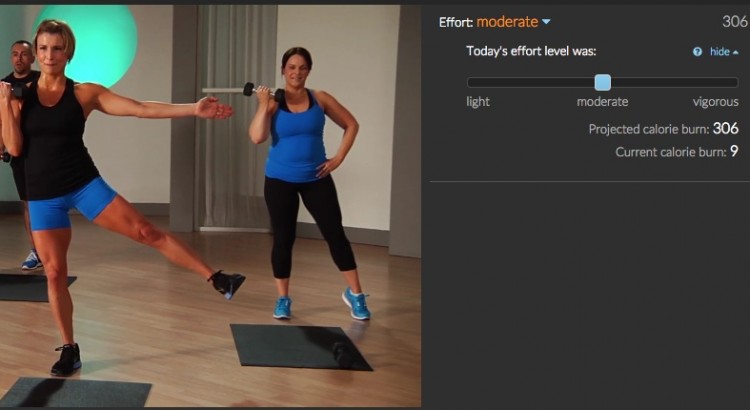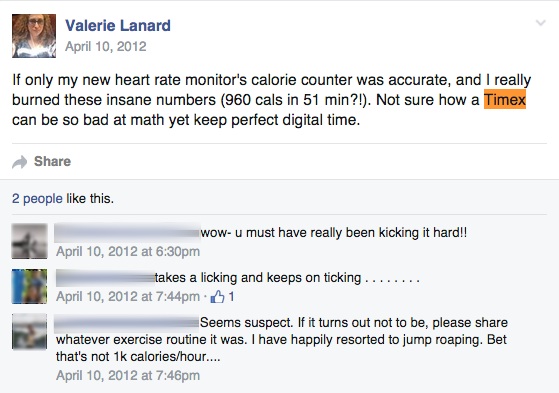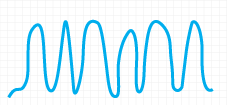Ever thought about where calorie estimates come from for different exercises? In order to add calorie burn to over 100 workout videos (formerly hosted) on Gigabody, we dug in to find out. Turns out it is no simple feat to do calorie estimation well.
Calorie burn depends on the following:
- the nature and intensity of the activity
- your heart rate moment by moment
- your effort on a given day
- your VO2max (maximum oxygen available for use)
- your metabolism, which differs per individual and varies with age, height, weight, gender, fitness, and lean body mass
Most of the time, it’s nearly impossible to measure all of these elements throughout your exercise, unless you happen to have access to a sophisticated lab or professional sports training facility. So designers rely on common formulas to estimate calorie burn within websites, apps, fitness trackers, and gym machines by filling in as many of the variables as possible. The fewer variables there are as input, the less accurate the estimates will be.
Let’s break down some of these variables.
The nature and intensity of the activity
Exercise intensity is most commonly measured through the MET scale. A MET score (the Metabolic Equivalent of a Task) is a score assigned to a physical activity is a score assigned to a physical activity, where 1 MET is roughly equivalent to 1 minute of sitting quietly in terms of the energy it takes to perform. There are basic formulas to estimate the caloric burn of many common activities using published MET scores, and these formulas are used by tools like gym machines and fitness apps.
But there is a problem. The MET was originally designed to measure effort across a population, not to be used at an individual level. When applied to only one person, it turns out that there are significant inaccuracies in the estimated calorie burn numbers derived from METs because a standard MET doesn’t take into account age, body mass, or gender. Two people of very different makeup do not burn the same amount of calories for the identical activity! For instance, men burn more calories than women in general.
To improve the accuracy of using METs for calorie estimates, a revised formula was put forth in 2011 that allows us to correct the MET score per individual, based on his or her height, weight, age, and gender. These characteristics are first used to derive the person’s estimated RMR (resting metabolic rate), or the amount of calories burned on a given day just by being alive. With the RMR, we can derive a weighted value for each individual that allows us to customize any standard MET score for that individual, to estimate a more personalized calorie count for an activity.
Even the corrected MET is not a perfect science though. Lean body mass, fitness level, genetics, and individual variation are still not factored into the equation. But corrected METs are a marked improvement over the standard MET, according to the scientists behind the revised formulas.
Standard MET scores for exercises in workout videos
So which activities have a standard MET? You can browse the tables of standard METs on the Compendium of Physical Activities website. While many activities are included, the list is far from complete and rather general.
Unlike a steady state activity such as running, workout videos vary significantly across the board in terms of format, content, and pace. There’s no one-size-fits-all formula to calculate calories across an entire library of workout videos, despite the published entries shown below for “video exercise workouts”. We’d love to know what videos were used as the basis for these numbers. Jane Fonda? Jillian Michaels? Richard Simmons?
Here are some activities from the standard MET tables that are relevant to different workout videos:
| standard MET score | activity |
|---|---|
| 2.8 | calisthenics (e.g., situps, abdominal crunches), light effort |
| 3.8 | calisthenics (e.g., push ups, sit ups, pull-ups, lunges), moderate effort |
| 8.0 | calisthenics (e.g., push ups, sit ups, pull-ups, jumping jacks), vigorous effort |
| 4.3 | circuit training, moderate effort |
| 8.0 | circuit training, including kettlebells, some aerobic movement with minimal rest, general, vigorous intensity |
| 5.0 | resistance (weight) training, squats , slow or explosive effort |
| 2.3 | stretching, mild |
| 3.0 | pilates, general |
| 2.3 | video exercise workouts, TV conditioning programs (e.g., yoga, stretching), light effort |
| 4.0 | video exercise workouts, TV conditioning programs (e.g., cardio-resistance), moderate effort |
| 6.0 | video exercise workouts, TV conditioning programs (e.g., cardio-resistance), vigorous effort |
| 2.5 | yoga, Hatha |
| 5.0 | aerobic, low impact |
| 7.3 | aerobic, high impact |
| 7.5 | aerobic, step, with 6 – 8 inch step |
| 5.0 | ballet, modern, or jazz, general, rehearsal or class |
| 6.8 | ballet, modern, or jazz, performance, vigorous effort |
And that’s just a sample!
Your heart rate moment by moment
Your heart rate can be measured using a heart rate monitor with a chest strap, a wrist-based pulse tracker (like Fitbit Charge, Jawbone 3, etc), or even by hand using a watch and counting the beats felt on your wrist or neck over a period of 60 seconds.
Heart rate is not a perfect means of estimating calorie burn, but it is strongly correlated. That is, if you are working intensely, your heart rate will be elevated within a certain range or spike up to that. In contrast, if your effort is light, your heart rate will typically be much lower.
The most accurate heart rate monitors when it comes to calorie burn reporting are those models that allow you to enter your age, weight, height, and most importantly, gender. If V02Max can be entered, that is also a plus, since a manual measurement is likely to be more reliable than the standard age-based formula.
Men burn significantly more calories than women in general, so without the ability to specify your gender, any calorie reporting from a heart rate monitor is suspect. Some inexpensive, unisex models do not allow the wearer to customize these settings, so this is very important to look out for when considering a heart rate monitor.
One tell-tale sign of a less accurate heart rate monitor is one that always credits you with burning 10-20 calories per minute *regardless of activity*. So unfair, right? Only the most vigorous intensity workouts burn that many calories, activities like running, jumping rope, tabata, and hiking uphill. The serious huff and puff stuff.
Here’s how I learned about this, firsthand.
960 calories doing a moderate intensity workout video in my living room? Didn’t I wish! For the record, Timex is a great company and they have a wide range of devices, but I had a budget model that couldn’t be customized. Thankfully, the price of customizable heart rate monitors has come down A LOT in the last several years.
Device calorie estimates can be wildly inaccurate when:
- you lack the ability to enter the proper inputs to personalize your results
- they default to the best case scenario (perhaps programmed for a 22 year old buff guy?)
If you track calories or use exercise to offset your diet, you need to know the true numbers. That said, it is possible to burn 10-20 calories per minute in your living room. It just requires a lot of determination and the right activity.
Read more about intensity levels here: Moderate To Vigorous – What is Your Level of Intensity?
Heart rate monitors with a chest strap are the most accurate in terms of reporting calorie burn across all activities – from continuous movement like running to bursty activities like strength and interval training.
Wrist-based pulse monitors — that is heart rate monitors without a chest strap — do well at assessing calorie burn and heart rate for steady-state activities like jogging, but do not yet have the sensitivity to accurately report on spiky and intermittent heart rate activities such as strength training, interval training, and pilates. For now, many of the best at-home workout activities, the ones frequently featured in workout videos, cannot be accurately measured with wrist based pulse readings.
Your Effort on a Particular Day
If you don’t have a heart rate monitor or real-time oxygen and pulse data, self-reported effort (on a light/moderate/vigorous scale) is a reasonable substitute.
Let’s first think about why effort is a reasonable substitute for your heart rate on a given day. Picture the following graphs, showing hypothetical exertion patterns during 3 different types of activities, each 30 minutes long. When the line is high, you are breathing and working heavily. When it’s low, you can catch your breath and hold a conversation easily.
You could map your heart rate pretty closely to your effort, minute by minute, for each workout above. But as you can imagine looking at these graphs, there is no one pattern for “workout video” that would apply to all videos. Workout videos span every format and “shape” imaginable, and thus no one MET score is going to be right for all videos, despite the generalized entries found in the standard MET table.
One day soon, when the Internet of Things has connected everything around us, we will measure your real-time heart rate during video exercise, measure your oxygen uptake, and compute finely accurate numbers for every single video workout you do. But until then, your reported effort is the best proxy for pinpointing your calorie burn.
Of course, which activities feel vigorous may vary from person to person, based on individual body type, fast or slow twitch muscle fiber, and fitness level. What feels vigorous (or light) even to the same person may vary day to day, based on hormones, sleep levels, illness, and energy.
How Gigabody estimated calories
Now that you understand the basics of how calorie counts are estimated, here is how Gigabody calculated individualized calorie burn.
Every single Gigabody workout video had a custom MET score derived from the following:
- the standard MET tables as a starting point
- the formula to correct METs for an individual based on age, height, weight, and gender
- a wide sampling of Gigabody workouts done with a high-quality heart rate monitor, across varying levels of intensity
Our workout videos ranged from a standard MET of 2.3 (for yoga and stretching videos with light effort) up to 9 (for our most strenuous and plyometric workouts). Obviously the published standard of 6 METs for a ‘vigorous’ video workout was not even close to accurate for some of our workouts, though many did fall into that range.
You could customize your effort level after every workout you did on Gigabody, choosing from 5 levels of intensity — light through vigorous. This pinpointed the most accurate MET score for your intensity on that workout.
We then calculated your corrected MET value per workout based on your reported effort and personal characteristics. And from this information, we were able to estimate your personalized calorie burn per workout. Voila!
As you can see, accurate calorie estimation is no simple feat. We hope you enjoyed learning about how we implemented it at Gigabody. Bring on the burn!





Great blog, thanks for sharing this amazing calorie workout.
This is one lovely read! I appreciate your post. More power to you!